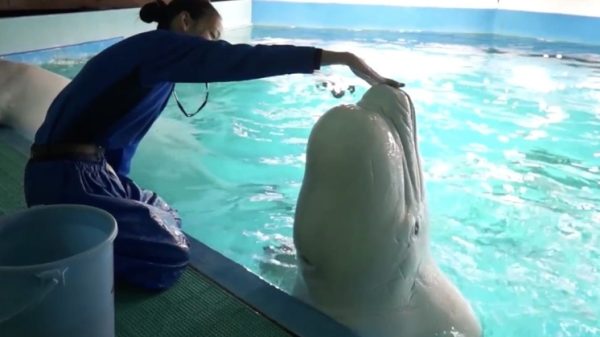
A dwarf giraffe, Nigel, right, and an adult male giraffe in Namibia
Credit: REUTERS
Standing at 9ft 6in, the animal towered over the conservationists who discovered it in a remote area of Uganda five years ago.
Yet Gimli, the giraffe, will go down in natural history books not for its height — but for the lack of it.
Discovered roaming around Murchison Falls National Park, the animal has been identified as the first known example of a "dwarf giraffe", standing far short of the 16ft usually reached by the Nubian species.
When pictures of him first began circulating online, some experts assumed that they had been digitally altered.
"I didn’t believe it at first," David O’Connor, president of Save Giraffes Now, told The New York Times. "I thought it was Photoshopped, to be honest."
The story of Gimli’s discovery was first disclosed last month in the journal BMC Research Notes. It also documents the life of a similar giraffe named Nigel, which was found in Namibia.
Naturalists believe the two creatures offer a rare opportunity to study how dwarfism affects their ability to adapt and survive.
Although the condition can affect domestic animals, such as cows and pigs, it is rare among wild animals, and has never been recorded in giraffes.
The precise cause of Gimli and Nigel’s dwarfism is not known, although it may be down to inbreeding caused by species decline.

Some species of giraffe can grow to about 19 feet tall
Credit: REUTERS
At one point, in the late Eighties, the population of Nubian giraffes dwindled to just 78. It is now back up to more than 1,500. With more than half of all wild giraffes dying before they reach maturity, both Gimli and Nigel have done well just to become adults, experts say.
But being small in such a grown-up world confers few advantages.
A giraffe’s superlative height is normally one of its main competitive advantages in the wild, allowing it to eat leaves from taller trees.
Its long legs are also powerful enough to kill a lion with a single kick if it tries to attack.
"It’s easy to imagine how this might make them more susceptible to predation since they lack the ability to effectively run and kick, which are two of the giraffe’s most effective anti-predator tactics," said Dr Michael Brown, a conservation science fellow with the Giraffe Conservation Foundation and the Smithsonian Conservation Biology Institute.
Dr Brown — who came across Gimli in 2015 — and his colleagues now hope to monitor the two dwarf giraffes over the course of their lives.
He said he hoped for "some interesting stories and neat little wrinkles about how animals that have these types of conditions cope with changing environments".
One story he may not get to document, however, is that of Gimli or Nigel starting a family. The height difference between them and the average female giraffe makes it very unlikely that either will ever hear the patter of tiny hooves.
"Given the mechanics of giraffe mating, I’d speculate that for both of these giraffes, mating would be physically challenging," Dr Brown said.
Read more: Public killing giraffes for food as virus ravages Kenya’s economy and leaves millions hungry






















































Свежие комментарии